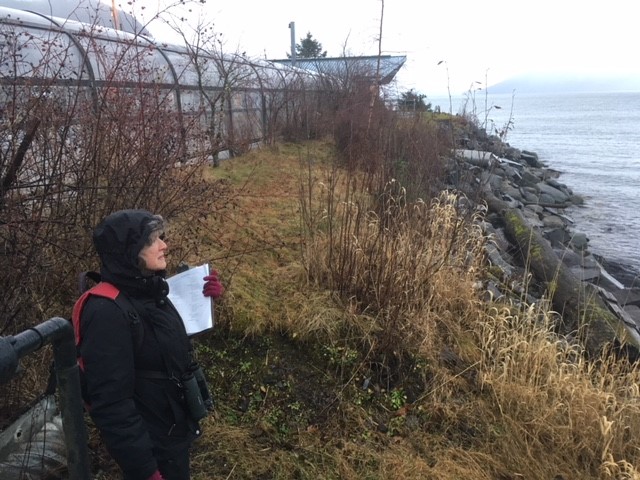
Bonnie Demerjian has been organizing the Christmas Bird Count in Wrangell for about 15 years. (June Leffler/ KSTK).
Every year birders conduct the Christmas Bird Count. It’s a citizen scientist effort to collect data on birds that live year round in North American communities. I went out with these wildlife enthusiasts in Wrangell on Dec. 16 to take part in the count.
Bonnie Demerjian has been organizing Wrangell’s Christmas Bird Count for about 15 years. I meet up with her at City Dock to spot the usual crowd of Glaucous-winged seagulls, crows and ravens. There’s a man in his car feeding the birds.
MAN: I feed them every day.
DEMERJIAN: Do you? Well you’re their friend aren’t you.
MAN: Are you counting all them?
DEMERJIAN: I’m going to count them all, thank you for bringing them so close.
On this day, birdwatchers all over North America count resident fowl, the ones that stay year-round. It’s a project of the National Audubon Society. It’s been going on for over 100 years. Demerjian and two dozen other wildlife explorers are canvassing a 14-mile-wide area in Wrangell. Together, they end up spotting 54 different species, and counting almost 4000 birds total.

The map shows the seven mile radius that birders are exploring for the Christmas Bird Count. (KSTK/June Leffler)
DEMERJIAN: It’s what they call citizen science. Having people who are not experts, but are contributing in whatever way they can. And this just helps builds up this body of data that can then be used for all kinds of scientific purposes.
Demerjian and I walk to the ferry terminal and then Petroglyph Beach, looking for birds feeding just off the shore.
She identifies different species visually, by the shape of their body and markings. The birds’ vocalization tips her off too. And simply knowing the environment will tell a birder what to expect.
DEMERJIAN: How do you do it, you do it bird by bird, you start acquiring an understanding just a little bit at a time. I think that’s one of the reason people get so involved in birding is because there’s never an end to it, you never know it all.
She has her binoculars and a hardcopy field guide. She takes out her iPad with a birding app.
DEMERJIAN: The calls *ipad plays call* so that’s helpful sometimes if you’re out someplace and you’re not sure what you’re listening to.
She also has a clipboard with a list of all the birds she can expect to see. It’s on weather-proof paper.
DEMERJIAN: This is a special paper, called write in the rain paper, and you can see why we need it.
We meet up with our fellow birders, Tori Hauser and her two boys.
HAUSER: At the ferry terminal what was that big group of seabirds?
DEMERJIAN: That was Barrow’s goldeneyes. And they hang out there all winter long.
HAUSRE: Oh we were right see. And what was your count on them? 75 to 100?
DEMERJIAN: I said 90.
Demerjian, Hauser, her two boys and I continue to the baseball field and then the golf course. It’s been raining all day, and it’s not letting up. The weather is starting to get to me and the boys.
LEFFLER: Are you still having fun in all the cold?
BOY: Sort of… my feet are freezing.
At the golf course we see a group of guys, well, you know…
DEMERJIAN: There are people golfing? I can’t believe it.
*golf swing*
GOLFERS: Merry Christmas, oh perfect day for golfing.
DEMERJIAN: Perfect day for birding too.
I knew nothing about birds before today. But, I had heard rumors about birders. They are persistent, even relentless in their pursuit.
At this point, we’re not even seeing that many birds. Birds, like humans, don’t like the wind or rain. But then we go under a canopy of trees and we hear chirping.
HAUSER: Keep your voices down.
DEMERJIAN: That’s a very pretty little thing.
LEFFLER: What does it look like?
DEMERJIAN: It’s kind of grayish, fluffly all over. But on the top of its head it has an orangey-yellow stripe. You saw four? Oh good, let’s remember that. Okay we saw four kinglets another eagle and those dark birds.
We wrap up our day shortly after that.
LEFFLER: How was your birding experience?
HAUSER: It was moist, but it was fun *laughs*. We like to go with Bonnie, because we’re not bird experts but she is so we can learn a lot.
Demerjian tries to convince me that on a warm Spring day, birdwatching can actually be one of the most enjoyable things to do in town.












